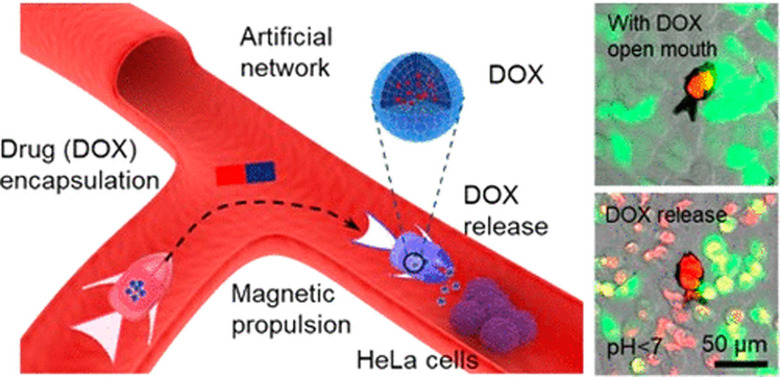Tiny Shape-Changing Microrobots Dispense Medicine Directly To Cancer Cells
One of the difficulties with treating cancer via chemotherapy is that most current chemotherapy techniques require medication to be delivered systemically. When medications are delivered systemically, they flow through the entire body to the specific cells where they are needed creating all kinds of side effects to the chemotherapy. Many cancer patients undergoing chemotherapy will tell you that the side effects from the drugs make them feel worse than cancer itself. Researchers are on the lookout for methods of delivering cancer drugs to fight tumors that don't produce side effects for the entire body.Researchers have now created tiny shape-changing microrobots that can deliver medications directly to the cells where they're needed. The microrobots are shaped like tiny fish and are guided directly to the cancer cells using a magnet. Once in the correct location of the body where cancer needs to be treated, a change in pH triggers the robots to open their fish-like mouths to deliver their medication payload.
In the past, microscale robots smaller than 100 µm were designed to manipulate small objects. However, they could not change shape, something required to perform complex tasks like releasing a medication. Another challenge with past robots of the type was that while some groups were able to design 4D printed objects, there were only able to perform simple actions. A 4D object is a 3D printed device able to change shape in response to a specific stimulus.

The new research saw a team of scientists develop shape-morphing microrobots guided by magnets to a specific site in the body. Since tumors are acidic, the team designed their robots to change shape in response to lowered pH. The first microrobots were created in the shape of crabs, butterflies, or fish using a pH-responsive hydrogel. The team was able to adjust the printing density in specific areas of the robot, such as along the edges of the crab claws, butterfly wings, or fish mouth, to encode pH-responsive shape-changing.
To make the minuscule robots magnetic, they were placed in a suspension of iron oxide nanoparticles. Throughout testing, the team was able to demonstrate the capabilities of the different types of robots. The fish-shaped robot features an adjustable mouth that can open and close. That shape was also found to be steerable through simulated blood vessels to reach cancer cells in a specific area of the petri dish.
As the pH of the surrounding solution in the dish was lowered, the fish opened its mouth to deliver the chemotherapy drug, which could kill cancer cells nearby. While the research is proof that the concept works, there is much work to be done before any potential human trials. As small as the microrobots are, they need to be even smaller to navigate blood vessels in the human body. The team also has to develop imaging methods to identify the robots inside the body and track their movement.
There's no indication when or if their new invention might begin human trials. Most of the research funding for this particular product came from Chinese sources. Recently, researchers at Princeton developed a new method for building soft robots. Their technique used a polymer to create soft robots able to deform into specific shapes to perform tasks like gripping objects. The soft robots have the strength to lift things like blueberries and are soft enough not to damage very soft and fragile objects.
